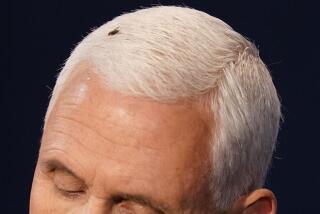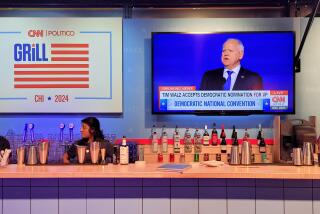Presidential Debate Planners Study San Diego Campus
- Share via
SAN DIEGO — The democratic process can now proceed: The Spin Alley location for the final presidential debate has been selected!
With national media representatives in tow, staffers for the Commission on Presidential Debates visited the University of San Diego on Monday, in preparation for the Oct. 16 debate between the two, or maybe three, top contenders for the world’s loftiest office.
And the first order of business was to find a spot where the “spin doctors,” those wily political operatives who will try to convince reporters that their candidate just scored a smashing victory, will be allowed to ply their trade.
The first suggestion, a large patio off the faculty dining room and blessed with a view of Mission Bay and the Pacific Ocean and a lusciously green urban canyon, was quickly rejected. Too fancy for a bunch of spin doctors. Better used as a smoking and relaxing area for the press.
Instead Spin Alley will be a roped off section of the Hahn University Center, the large meeting and dining hall that will serve as a work space for the hundreds of reporters covering the debate. The center is about 400 yards from Shiley Theatre, where the no-holds-barred 90-minute confrontation will take place.
To the untrained eye, Shiley is a gorgeous old theater (capacity 450) with Spanish Renaissance architecture and pin-drop acoustics. To the television networks, it’s an outrage.
For one thing, the balcony only has room for three platforms for network anchors. That’s at least one anchor short of a full load, and nobody wants to have to tell Bernard, Dan, Peter or Tom that he’s out of luck.
“A place less suited to television, I haven’t seen,” said John Reade, coordinating producer of special events for CBS News. “And these are not little problems, these are major problems.”
But the folks at USD are confident that Reade’s and other concerns will be overcome. So enthused are they about playing host to a presidential debate that the university is raising $1.2 million to renovate Shiley Theatre and $500,000 more to pay the costs of the debate.
Beyond just furthering the cause of democracy, USD officials are convinced that a presidential debate will provide the kind of international exposure that can help propel the independent, Catholic university (enrollment 6,380) into the academic big leagues.
“The competition for students is so intense, you need name recognition,” said USD spokeswoman Kate Callen. “And we’re going to get it, big time.”
Four years ago the campus was selected as presidential debate host, but the Bush and Clinton camps began to bicker about details and the USD debate was a goner. The university felt like the guy who had great tickets for the 7th game of the World Series only to have the series wrapped up in six.
“We’re glad you’re all here for San Diego II,” commission media director Bob Neuman told the media assemblage. “This time I think we’re going to go all the way.”
For the 1996 campaign, 43 universities and colleges jockeyed for one of four debates. The commission, a private, nonpartisan group founded in 1987, selected Washington University in St. Louis (Sept. 25), University of South Florida in St. Petersburg (Oct. 9) and USD (Oct. 16) for the presidential debates, and Trinity College in Hartford, Conn., (Oct. 2) for the vice presidential debate.
There is nothing, save the adverse news coverage it would engender, to keep one of the candidates from ducking a debate. Still, the commission has kept the Democratic and Republican national committees apprised of their planning, lest there be a repeat of 1992.
“We hope to avoid the debate-on-debates which seemed so foolish,” said the commission’s executive producer Bob Asman.
The San Diego debate will use the format made famous by the 1960 Kennedy-Nixon debates: a lone moderator and each candidate standing behind his own podium. The other debates will try round table and town-hall formats, allowing the audience to participate.
In time for the debate, Shiley Theatre, a narrow venue with a high-ceiling, will get air-conditioning, plush seating to replace the pew benches, and state-of-the-art sound and lighting systems. The latter is particularly important for television. The final presidential debate in 1992 had a TV audience of 97 million, the biggest for any political event in history.
“The theater is not going to get larger, but it’s going to get a lot brighter,” assured Roger Manion, head of physical plant operations at the university.
As it stands now, there will be two lecterns at Shiley Theatre. If Ross Perot, or another candidate representing his Reform Party enters the campaign, a third one will be added.
If the 5-foot, 6-inch Perot is the candidate, there will be also a riser for him to stand on so that he will see eye-to-eye-to-eye with President Clinton and the expected Republican candidate, Bob Dole, both of whom are 6 feet, 2.
More to Read
Get the L.A. Times Politics newsletter
Deeply reported insights into legislation, politics and policy from Sacramento, Washington and beyond. In your inbox twice per week.
You may occasionally receive promotional content from the Los Angeles Times.










